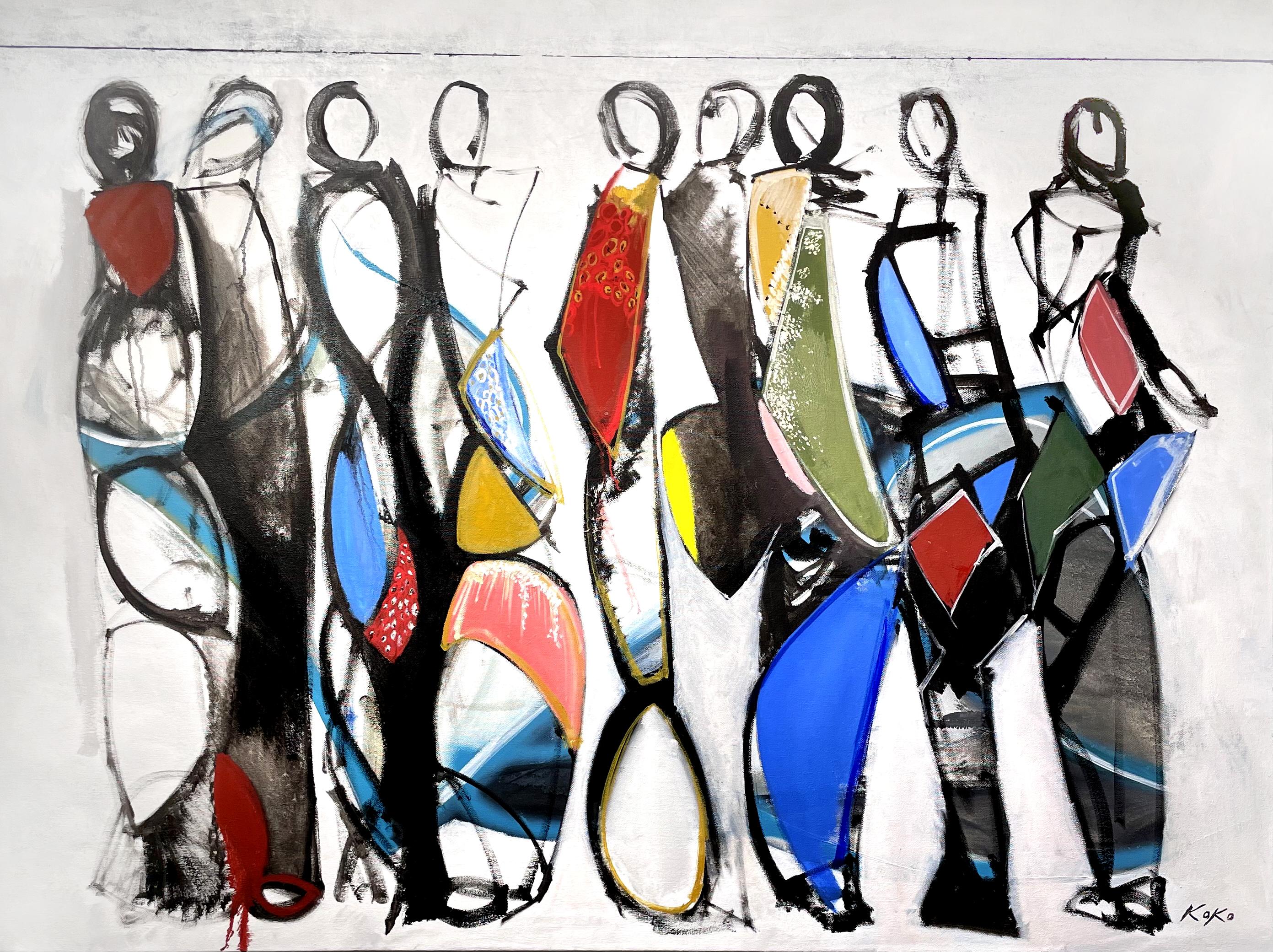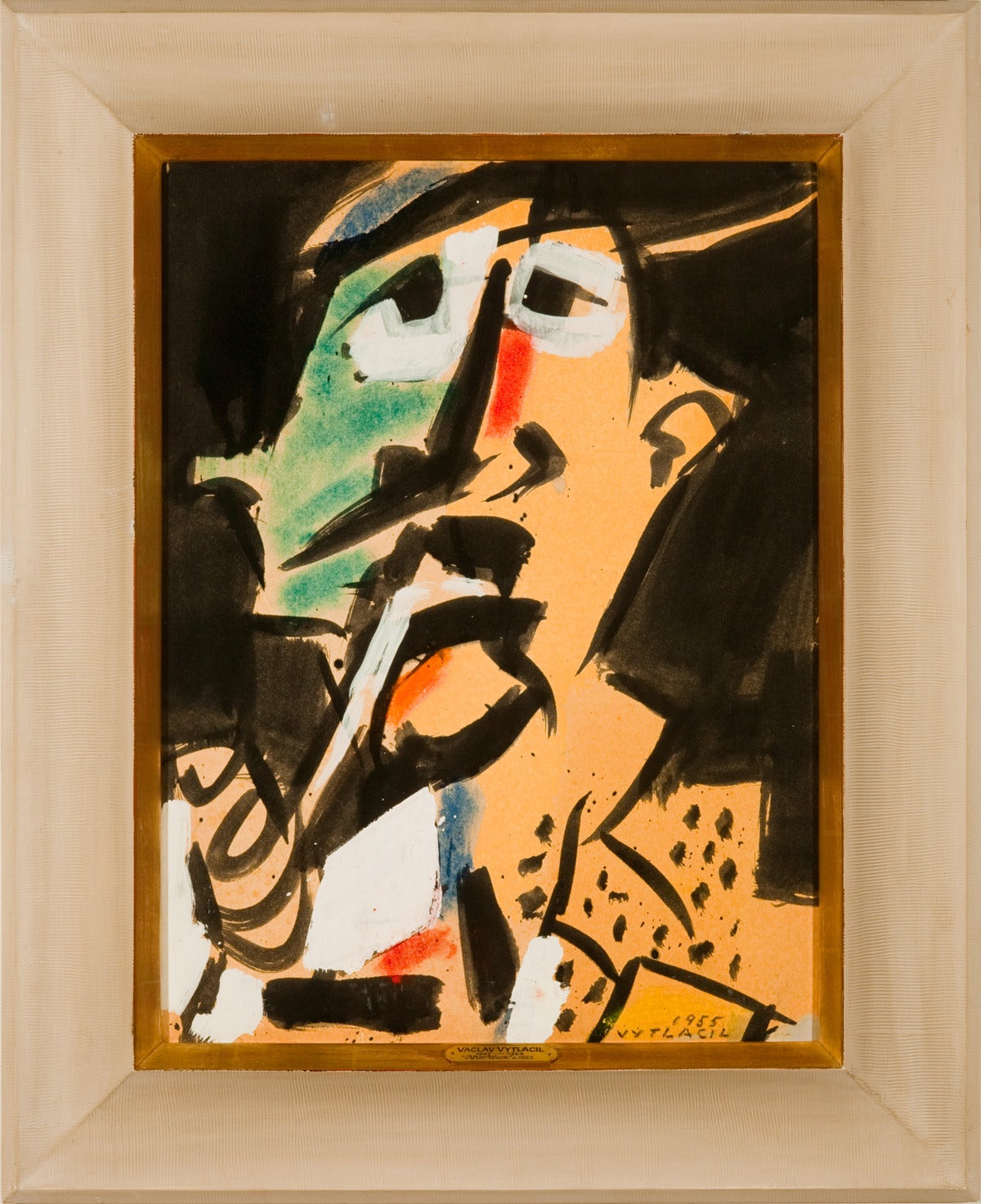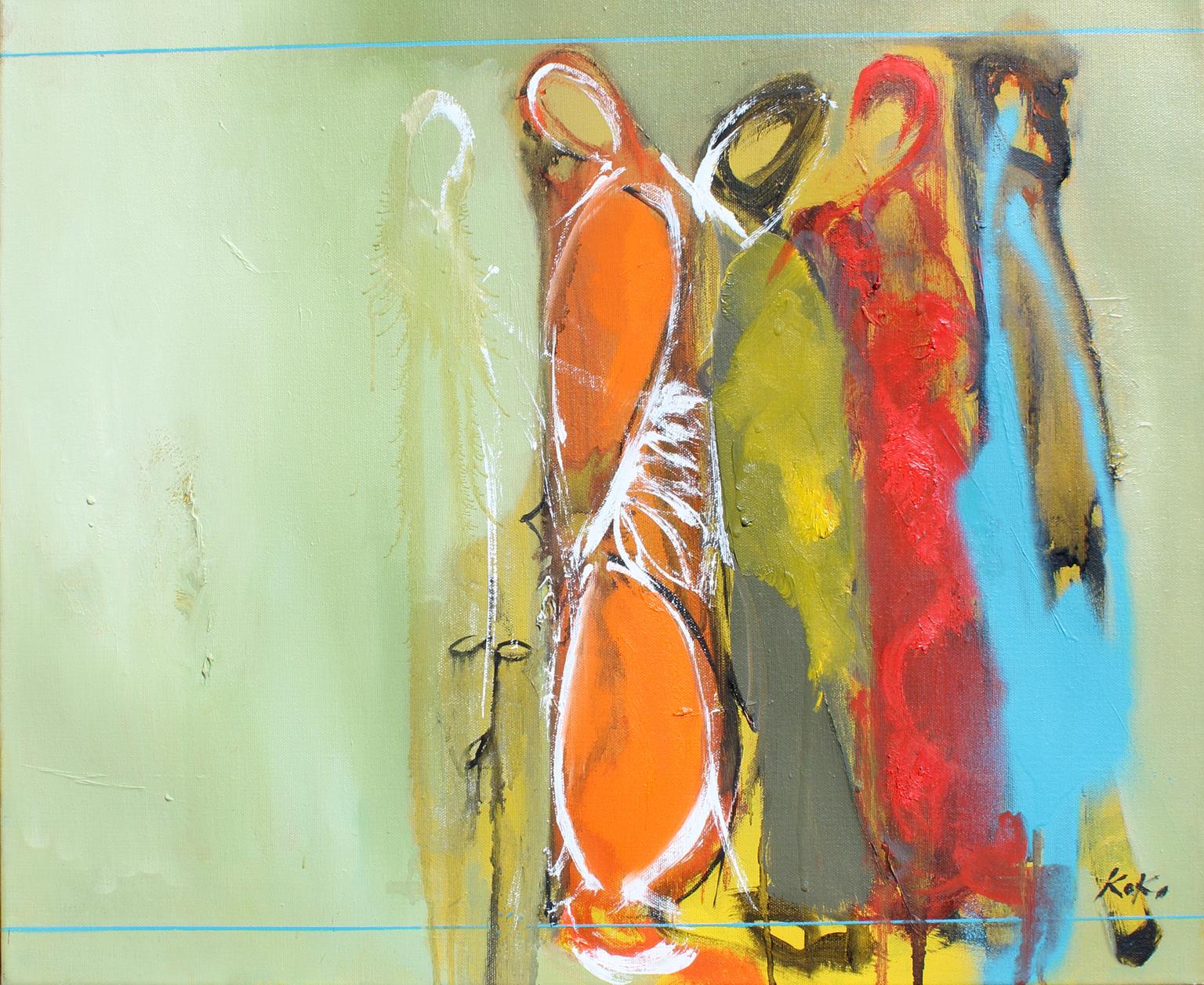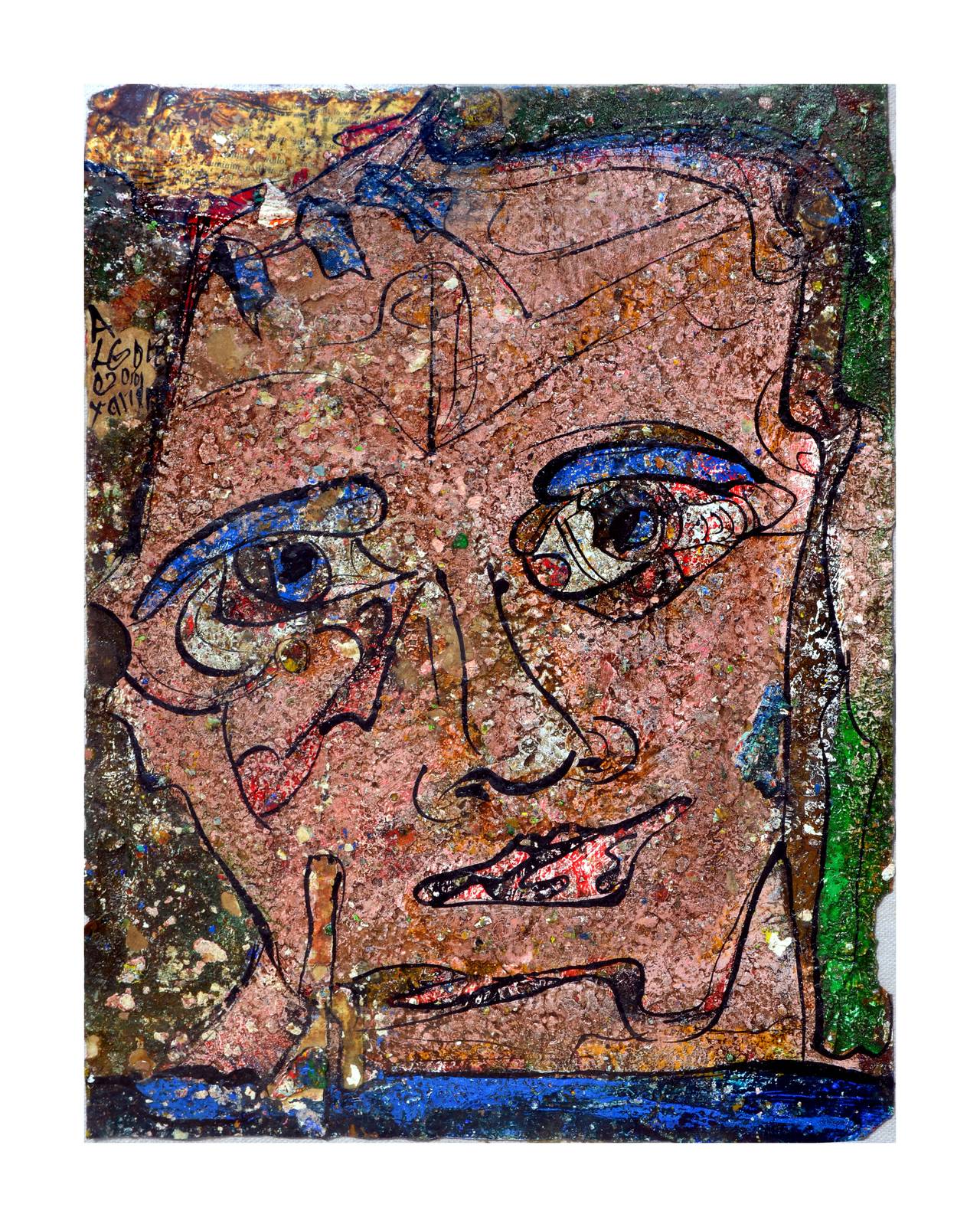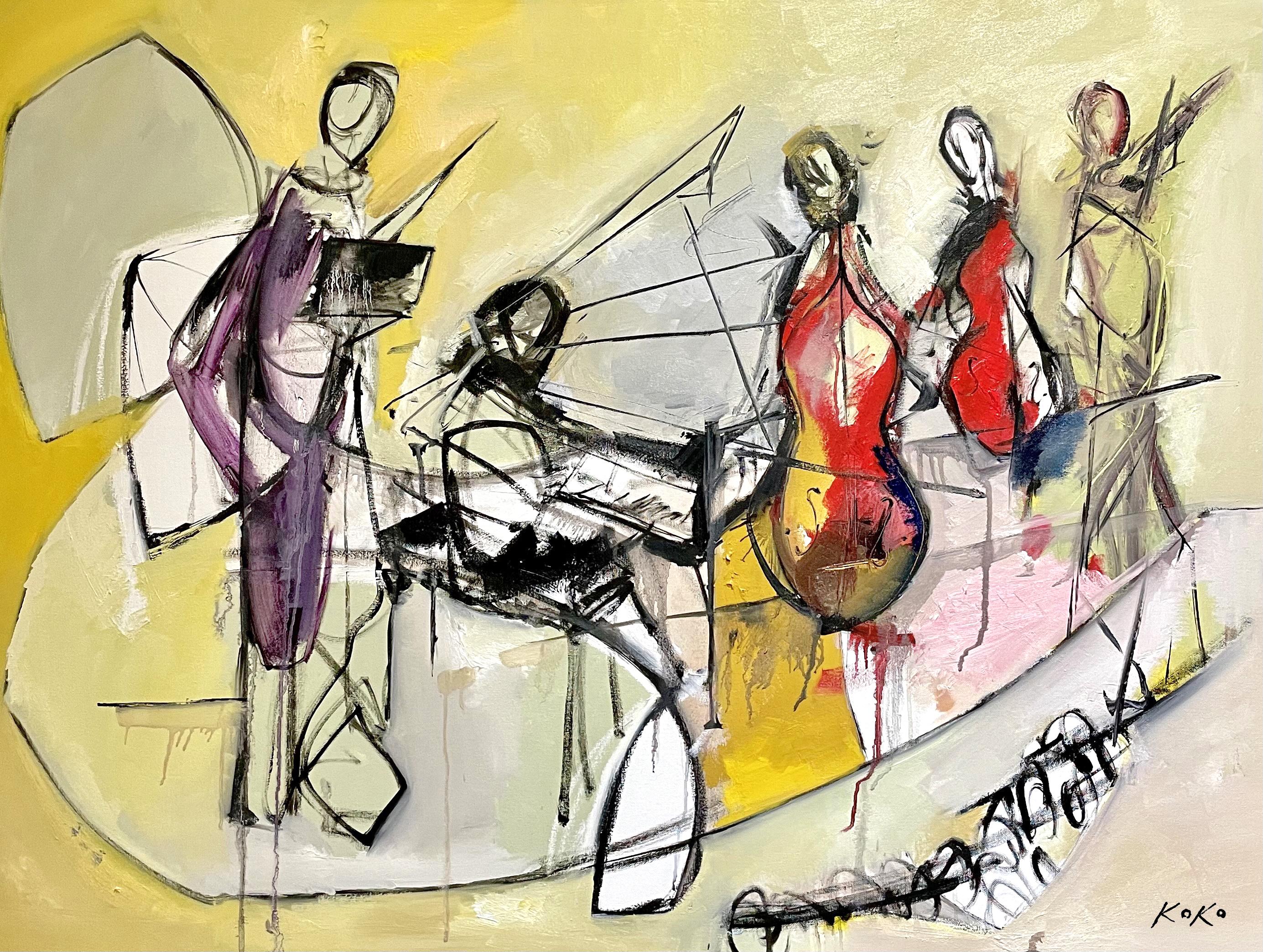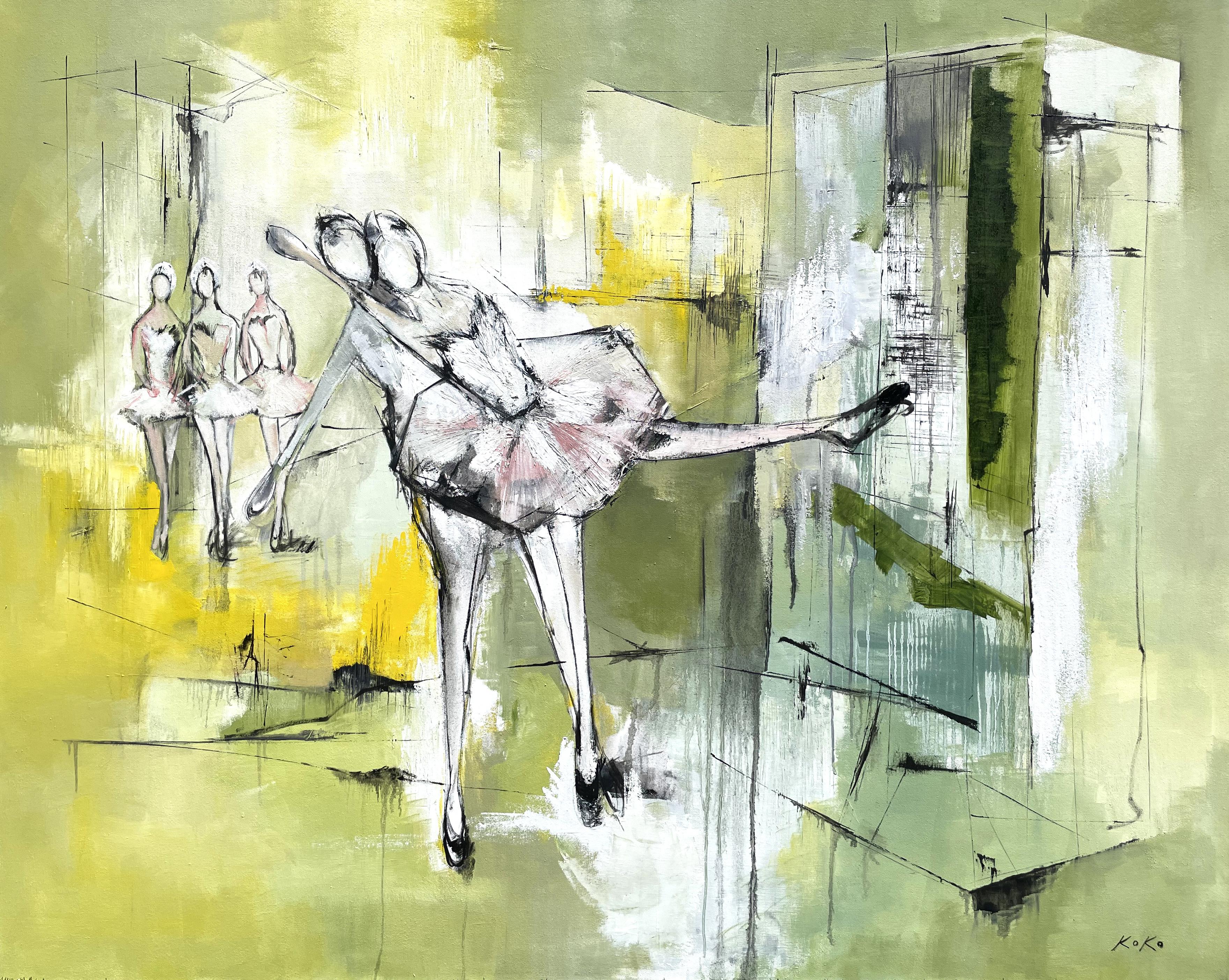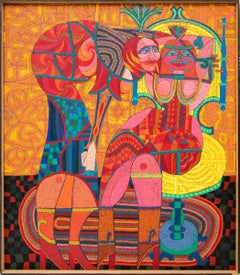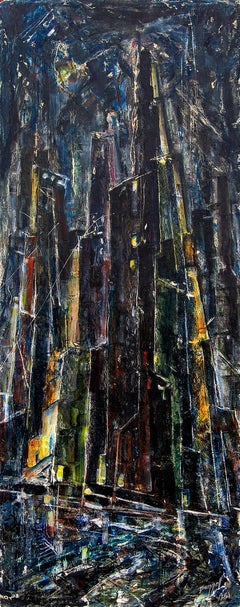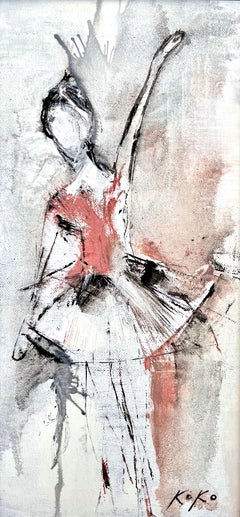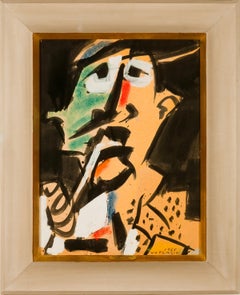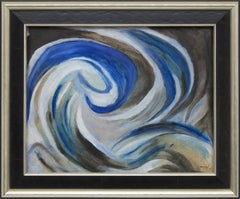
1960s Abstract Oil Painting, Mid Century Modern Painting, Blue, White, Gray
View Similar Items
Video Loading
Want more images or videos?
Request additional images or videos from the seller
1 of 14
Charles Ragland Bunnell1960s Abstract Oil Painting, Mid Century Modern Painting, Blue, White, Gray1963
1963
About the Item
- Creator:Charles Ragland Bunnell (1897-1968, American)
- Creation Year:1963
- Dimensions:Height: 21 in (53.34 cm)Width: 25 in (63.5 cm)Depth: 1.25 in (3.18 cm)
- Medium:
- Movement & Style:
- Period:
- Framing:Frame IncludedFraming Options Available
- Condition:very good vintage condition.
- Gallery Location:Denver, CO
- Reference Number:Seller: DCG-217481stDibs: LU2732592611
About the Seller
5.0
Platinum Seller
These expertly vetted sellers are 1stDibs' most experienced sellers and are rated highest by our customers.
Established in 1979
1stDibs seller since 2013
Typical response time: 5 hours
More From This SellerView All
- Sybils Telling Cosmic Jokes On Mankind, Framed Figurative Abstract Oil PaintingBy Edward MarecakLocated in Denver, COVintage 1960s original semi abstract oil painting, "Sybils Telling Cosmic Jokes On Mankind", by 20th century Denver modernist, Edward Marecak (1919-1993). Painted in bright colors of...Category
1960s Abstract Figurative Paintings
MaterialsOil, Canvas
- The King, Mid Century 1958 Abstract Oil Painting, Green Bold Primary ColorsBy Robert Jay WolffLocated in Denver, CO'The King', 1950s abstract oil painting by Robert Wolff (1905-1979), painted in bold colors of red, yellow, green, orange, blue, and black. Oil on canvas, signed, titled, and dated 1...Category
Mid-20th Century Abstract Abstract Paintings
MaterialsOil, Canvas
$15,400 Sale Price20% Off - New York City Abstract Skyline, Semi Abstract Night Scene Cityscape Oil PaintingBy Charles Ragland BunnellLocated in Denver, COOil on board painting of abstracted New York City skyline by Charles Ragland Bunnell from 1951. Nocturne cityscape painted in colors of black, shades of blue, and yellow. Presented in a custom black frame, outer dimensions measure 30 ¼ x 12 ¼ x ¾ inches. Image size is 30 x 12 ¼ inches. Painting is in good vintage condition - please contact us for detailed condition report. Provenance: Estate of Charles Ragland Bunnell Expedited and international shipping is available - please contact us for a quote. About the Artist: Charles Bunnell developed a love for art at a very young age. As a child in Kansas City, Missouri, he spent much of his time drawing. When he was unable to find paper he drew on walls and in the margins of textbooks for which he was often fined. Around 1915, Bunnell moved with his family to Colorado Springs, Colorado. He served in World War I and later used his GI Training to study at the Broadmoor Art Academy (later renamed the Colorado Springs Fine Arts Center) during 1922 and 1923. In 1922, he married fellow student, Laura Palmer...Category
1950s Abstract Abstract Paintings
MaterialsOil, Board
- Adam and Eve, 1980s Abstract Figurative Painting, Vertical Oil Painting, 30 x 48By Edward MarecakLocated in Denver, COOil painting on foam core titled "Adam and Eve" by Denver artist Edward Marecak (1919-1993) from 1983. Portrays two semi-abstract figures with shapes in the background, painted in colors of pink, blue, yellow, and brown. Presented in a custom wooden frame, outer dimensions measure 30 ⅞ x 48 ⅞ x 2 ⅝ inches. Image size 30 x 48 inches. Painting is in good vintage condition - please contact us for a detailed condition report. Provenance: Estate of Edward Marecak About the Artist: Born to immigrant parents from the Carpathian region in Slovakia, Marecak grew up with his family in the farming community of Bennett’s Corners, now part of the town of Brunswick, near Cleveland, Ohio. When he turned twelve, his family moved to a multi-ethnic neighborhood of Poles, Czechs, Slovaks, and Slovenians in Cleveland. His childhood household cherished the customs and Slavic folk tales from the Old Country that later strongly influenced his work as a professional artist. His junior and senior high projects earned him a full scholarship to the Cleveland Institute of Art (1938-1942) where he studied with Henry George Keller whose work was included in the 1913 New York Armory Show. In 1940 Marecak also taught at the Museum School of the Cleveland Institute. Before being drafted into the military in 1942, he briefly attended the Cranbrook Academy of Art near Detroit, one of the nation’s leading graduate schools of art, architecture, and design. Marecak’s studies at Cranbrook with painter Zoltan Sepeshy...Category
1980s Abstract Abstract Paintings
MaterialsOil
- Winter Witches in an Upside World Interfering with Each Other, Semi-Abstract OilBy Edward MarecakLocated in Denver, COOil painting on burlap by Edward Marecak (1919-1993) titled "Winter Witches in an Upside World Interfering with Each Other" from 1990. Titled and dated by the artist on verso. Painted in shades of black, gray, red, purple, and green. Presented in the original artist frame, outer dimensions measure 44 ⅛ x 44 ⅛ x 1 ⅜ inches. Image size is 43 x 43 inches. About the artist: Edward Marecak Born Ohio 1919 Died Colorado 1993 Born to immigrant parents from the Carpathian region in Slovakia, Marecak grew up with his family in the farming community of Bennett’s Corners, now part of the town of Brunswick, near Cleveland, Ohio. When he turned twelve, his family moved to a multi-ethnic neighborhood of Poles, Czechs, Slovaks, and Slovenians in Cleveland. His childhood household cherished the customs and Slavic folk tales from the Old Country that later strongly influenced his work as a professional artist. During junior high he painted scenery for puppet shows of “Peter and the Wolf,” awakening his interest in art. In his senior year in high school he did Cézanne-inspired watercolors of Ohio barns at seventy-five cents apiece for the National Youth Administration. They earned him a full scholarship to the Cleveland Institute of Art (1938-1942) where he studied with Henry George Keller whose work was included in the 1913 New York Armory Show. In 1940 Marecak also taught at the Museum School of the Cleveland Institute. Before being drafted into the military in 1942, he briefly attended the Cranbrook Academy of Art near Detroit, one of the nation’s leading graduate schools of art, architecture, and design. A center of innovative work in architecture, art and design with an educational approach built on a mentorship model, it has been home to some of the world’s most renowned designers and artists, including Eero Saarinen, Charles Eames, Daniel Libeskind and Harry Bertoia. Marecak’s studies at Cranbrook with painter Zoltan Sepeshy and sculptor Carl Milles were interrupted by U.S. army service in the Aleutian Islands during World War II. Following his military discharge, Marecak studied on the G.I. Bill at the Colorado Springs Fine Arts Center from 1946 to 1950, having previously met its director, Boardman Robinson, conducting a seminar in mural painting at the Cleveland Institute of Art. Although he did not work with Robinson at the Fine Arts Center, who had become quite ill - retiring in 1947 - he studied Robinson’s specialty of mural painting before leaving to briefly attend the Cranbrook Academy in 1947. That same year he returned to the Fine Arts Center, studying painting with Jean Charlot and Mary Chenoweth, and lithography with Lawrence Barrett with whom he produced some 132 images during 1948-49. At the Fine Arts Center he met his future wife, Donna Fortin, whom he married in 1947. Also a Midwesterner, she had taken night art courses at Hull House in Chicago, later studying at the Art Institute of Chicago with the encouragement of artist Edgar Britton. After World War II she studied with him from 1946 to 1949 at the Fine Arts Center. (He had moved to Colorado Springs to treat his tuberculosis.) Ed Marecak also became good friends with Britton, later collaborating with him on the design of large stained glass windows for a local church. In 1950-51 Marecak returned to the Cleveland Institute of Art to complete his Bachelor of Fine Arts degree. A year later he was invited to conduct a summer class at the University of Colorado in Boulder, confirming his interest in the teaching profession. In 1955 he received his teaching certificate from the University of Denver. Vance Kirkland, the head of its art department, helped him get a teaching job with the Denver Public Schools so that he and his family could remain in the Mile High City. For the next twenty-five years he taught art at Skinner, Grove, East, George Washington and Morey Junior High Schools. Prior to coming to Colorado, Marecak did watercolors resembling those of Winslow Homer, John Singer Sargent and Charles Burchfield. However, once in Colorado Springs he decided to destroy much of his earlier oeuvre, embarking on a totally new direction unlike anything he had previously done. Initially, in the 1940s, he was influenced by surrealist imagery and Paul Klee and in the West by Indian petroglyphs and Kachinas. His first one-person show at the Garrett Gallery in Colorado Springs in 1949 featured paintings and lithographs rendered in the style of Magic Realism and referential abstraction. The pieces, including an oil Witch with Pink Dish, foreshadowed the output of his entire Colorado-based career, distinguished by a dramatic use of color, intricacy of execution and attention to detail contributing to their visual impact. He once observed, “Each time I start a new painting I always fool myself by saying this time keep it simple and not get entangled with such complex patterns, color and design; but I always find myself getting more involved with richness, color and subject matter.” An idiosyncratic artist proficient in oil, acrylic, watercolor, gouache, and casein, he did not draw upon Colorado subject matter for his work, unlike many of his fellow painters in the state. Instead he used Midwest landscape imagery, bringing to life in it witches and spirits adapted from the Slovakian folk tales he heard growing up in Ohio. A number of his paintings depict winter witches derived from the Slovak custom in the Tatra Mountains of burning an effigy of the winter witch in the early spring to banish the memory of a hard winter. The folk tale element imparts a dream-like quality to many of his paintings. A devote of Greek mythology, he placed the figures of Circe, Persephone, Sybil, Hera and others in modern settings. The goddess in Persephone Brings a Pumpkin to her Mother, attired as a Midwestern farmer’s daughter, heralds the advent of fall with the pumpkin before departing to spend the winter season in the underworld. Train to Olympus, the meeting place of the gods in ancient Greece, juxtaposes ancient mythology with modernity creating a combination of whimsy and thought-provoking consideration for the viewer. Voyage to Troy #1 alludes to the ancient city that was the site of the Trojan Wars, but has a contemporary, autobiographical component referencing the harbor of the Aleutian Islands recaptured from the Japanese during World War II. In the 1980s Marecak used the goddess Hera in his painting, Hera Contemplates Aspects of the Art Nouveau, to comment on art movements in the latter half of the twentieth century Marecak’s love of classical music and opera, which he shared with his wife and to which he often listened while painting in his Denver basement studio, is reflected in Homage of Offenbach, an abstract work translating the composer’s musical colors into colorful palette. Pace, Pace, Mio Dio, the title of his earliest surrealist painting, is a soprano aria from Verdi’s opera...Category
1990s Abstract Figurative Paintings
MaterialsBurlap, Oil
- The Argument, 1960s Vintage Semi-Abstract Oil Painting in Reds, Pinks, and BlackBy Edward MarecakLocated in Denver, COOil on board painting by Edward Marecak (1919-1993) titled "The Argument" from 1968. Semi-abstract oil painting depicting two figures in colors of greens, pinks, blues, and blacks. Presented framed, outer dimensions measure 49 ½ x 33 ¼ x 1 ½ inches. Image size is 48 x 32 inches. Painting is clean and in very good vintage condition - please contact us for a detailed condition report. About the artist: Born to immigrant parents from the Carpathian region in Slovakia, Marecak grew up with his family in the farming community of Bennett’s Corners, now part of the town of Brunswick, near Cleveland, Ohio. When he turned twelve, his family moved to a multi-ethnic neighborhood of Poles, Czechs, Slovaks, and Slovenians in Cleveland. His childhood household cherished the customs and Slavic folk tales from the Old Country that later strongly influenced his work as a professional artist. During junior high he painted scenery for puppet shows of “Peter and the Wolf,” awakening his interest in art. In his senior year in high school he did Cézanne-inspired watercolors of Ohio barns at seventy-five cents apiece for the National Youth Administration. They earned him a full scholarship to the Cleveland Institute of Art (1938-1942) where he studied with Henry George Keller whose work was included in the 1913 New York Armory Show. In 1940 Marecak also taught at the Museum School of the Cleveland Institute. Before being drafted into the military in 1942, he briefly attended the Cranbrook Academy of Art near Detroit, one of the nation’s leading graduate schools of art, architecture, and design. A center of innovative work in architecture, art and design with an educational approach built on a mentorship model, it has been home to some of the world’s most renowned designers and artists, including Eero Saarinen, Charles Eames, Daniel Libeskind and Harry Bertoia. Marecak’s studies at Cranbrook with painter Zoltan Sepeshy and sculptor Carl Milles were interrupted by U.S. army service in the Aleutian Islands during World War II. Following his military discharge, Marecak studied on the G.I. Bill at the Colorado Springs Fine Arts Center from 1946 to 1950, having previously met its director, Boardman Robinson, conducting a seminar in mural painting at the Cleveland Institute of Art. Although he did not work with Robinson at the Fine Arts Center, who had become quite ill - retiring in 1947 - he studied Robinson’s specialty of mural painting before leaving to briefly attend the Cranbrook Academy in 1947. That same year he returned to the Fine Arts Center, studying painting with Jean Charlot and Mary Chenoweth, and lithography with Lawrence Barrett with whom he produced some 132 images during 1948-49. At the Fine Arts Center he met his future wife, Donna Fortin, whom he married in 1947. Also a Midwesterner, she had taken night art courses at Hull House in Chicago, later studying at the Art Institute of Chicago with the encouragement of artist Edgar Britton. After World War II she studied with him from 1946 to 1949 at the Fine Arts Center. (He had moved to Colorado Springs to treat his tuberculosis.) Ed Marecak also became good friends with Britton, later collaborating with him on the design of large stained glass windows for a local church. In 1950-51 Marecak returned to the Cleveland Institute of Art to complete his Bachelor of Fine Arts degree. A year later he was invited to conduct a summer class at the University of Colorado in Boulder, confirming his interest in the teaching profession. In 1955 he received his teaching certificate from the University of Denver. Vance Kirkland, the head of its art department, helped him get a teaching job with the Denver Public Schools so that he and his family could remain in the Mile High City. For the next twenty-five years he taught art at Skinner, Grove, East, George Washington and Morey Junior High Schools. Prior to coming to Colorado, Marecak did watercolors resembling those of Winslow Homer, John Singer Sargent and Charles Burchfield. However, once in Colorado Springs he decided to destroy much of his earlier oeuvre, embarking on a totally new direction unlike anything he had previously done. Initially, in the 1940s, he was influenced by surrealist imagery and Paul Klee and in the West by Indian petroglyphs and Kachinas. His first one-person show at the Garrett Gallery in Colorado Springs in 1949 featured paintings and lithographs rendered in the style of Magic Realism and referential abstraction. The pieces, including an oil Witch with Pink Dish...Category
1960s Abstract Abstract Paintings
MaterialsOil
You May Also Like
- Odette, Ballet, Ballerinas, contemporary artistBy KOKO HOVAGUIMIANLocated in La Canada Flintridge, CAOdette, painting size without framed is 8"x16", sighed Koko lower right. Koko's latest collection of paintings is based on the Story of 'Swan Lake,' the ballet composed by Tchaikovs...Category
2010s Abstract Expressionist Figurative Paintings
MaterialsOil
- 9 geometric figures. (colorful figures).By KOKO HOVAGUIMIANLocated in La Canada Flintridge, CA9 Geometric Figures is an abstract painting from a series of work by Los Angeles based artist Koko, exploring the energy of architecture and people. The unique and bold brushstrokes...Category
2010s Abstract Expressionist Abstract Paintings
MaterialsOil
- "After Work"By Vaclav VytlacilLocated in Lambertville, NJJim’s of Lambertville is proud to offer this artwork. Signed lower right Vaclav Vytlacil (1892-1984) He was born to Czechoslovakian parents in 1892 in New York City. Living in C...Category
20th Century Abstract Expressionist Abstract Paintings
MaterialsBoard, Oil
- Barroco Study, musicians selection, 20x24 in., oil on canvas. Signed lower rightBy KOKO HOVAGUIMIANLocated in La Canada Flintridge, CABarroco Study, 20x24 in., original oil on canvas. With framed size 22x26 inches. Signed lower right on the canvas. Koko’s musician series is part of his background as a classically ...Category
2010s Abstract Expressionist Abstract Paintings
MaterialsOil
- Identity, 20x24 in., oil on canvas. Original modern abstract expressionist.By KOKO HOVAGUIMIANLocated in La Canada Flintridge, CAIdentity, 20x24 in., oil on canvas by KOKO. Signed lower right. Koko’s abstract paintings have vivid colors, bold brushstrokes and unique qualities that create a connection between ...Category
2010s Abstract Expressionist Abstract Paintings
MaterialsOil
- "Unfinished Story", Contemporary Expressionist Modern Self-PortraitBy Alexander GoreLocated in Soquel, CAEvocative and expressive contemporary self portrait titled "Unfinished Story" by Alexander Gore (Russian, b. 1958), 2010. Signed upper left edge. Unframed. Image, 15"H x 11"W. Ale...Category
21st Century and Contemporary Abstract Expressionist Figurative Paintings
MaterialsOil, Paper, Cardboard
Recently Viewed
View AllMore Ways To Browse
Mid Century Modern Paintings
Mid Century Modern Painting
Mid Century Modern Abstract Art
Midcentury Black Painting
1960s Modern Painting
Mid Century Modern Oil Painting
Mid Century Modern Oil Paintings
Midcentury Modern Oil Paintings
Midcentury Modern Abstract Paintings
Midcentury Modern Abstract Painting
Vintage Mid Century Abstract
Midcentury Abstract Vintage
Mid Century White Painting
Mid Modern American Paintings
Modern Ink Abstract
Paintings From 1920s
Blue Mid Century Painting
Mid Century Modern Oil Painting Framed

